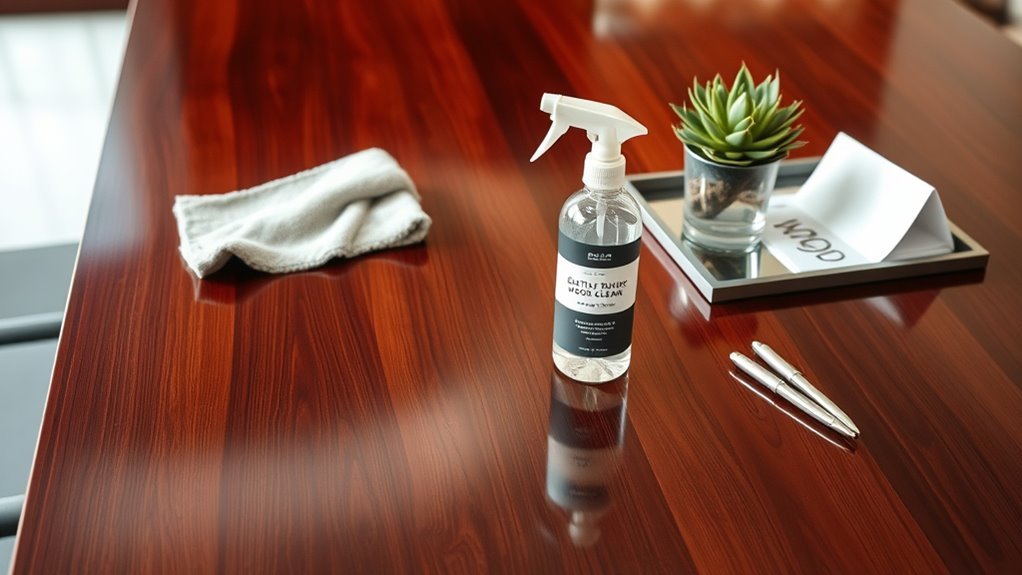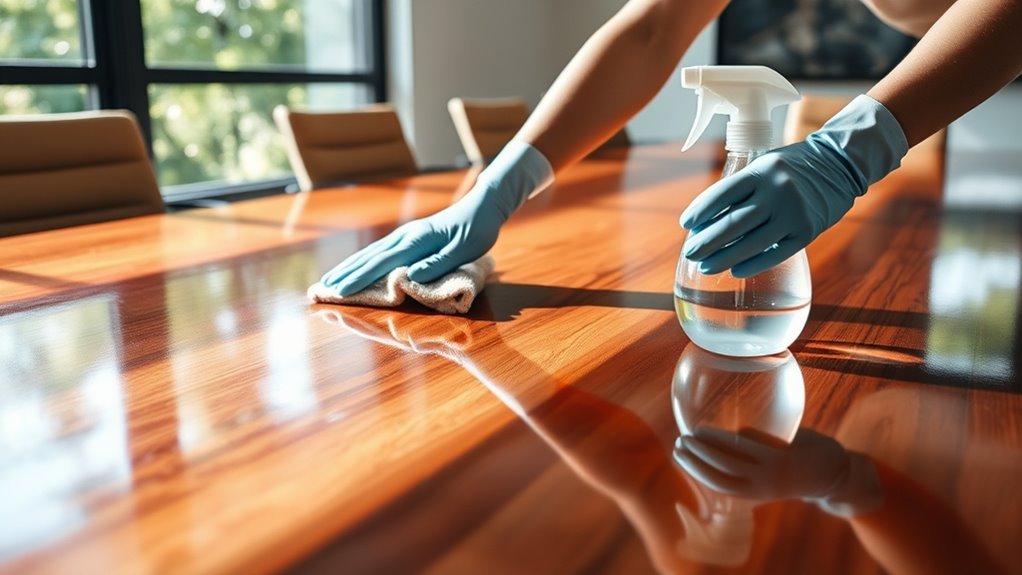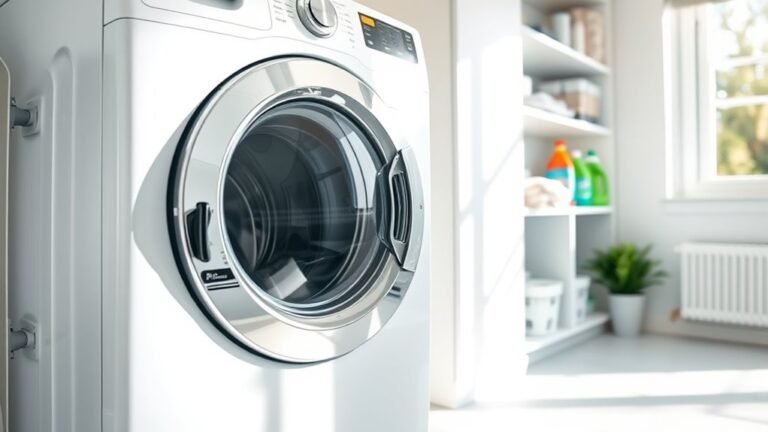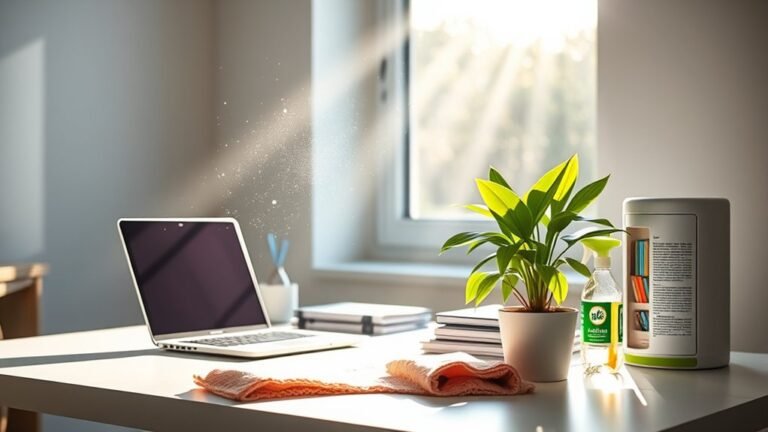How to Clean Conference Table
To clean your conference table, first identify its material—wood, glass, or laminate—and gather suitable supplies like microfiber cloths and mild cleaners. Remove dust with a soft cloth, then gently clean wood with a damp cloth and mild wood cleaner, glass with streak-free glass cleaner, and laminate with mild, non-abrasive solutions. Address spills promptly to avoid damage, and use coasters for protection. Proper care will extend its life, and further tips can help you maintain a pristine surface.
Assessing the Material of Your Conference Table

Before you begin cleaning, it’s important to identify the material of your conference table accurately. Understanding the material types—such as wood, glass, laminate, or metal—guides you in choosing the right cleaning method. Each material responds differently to cleaning agents and techniques. Next, assess the surface finishes: is it matte, glossy, or textured? These finishes affect how dirt and stains adhere and how delicate the cleaning process must be. For instance, a glossy finish may show streaks easily, requiring a gentler approach, while textured surfaces might trap debris, demanding more detailed attention. By methodically identifying both the material type and surface finish, you maintain your table’s integrity and extend its lifespan. This precise assessment frees you from guesswork and potential damage during cleaning.
Gathering Necessary Cleaning Supplies
To clean your conference table effectively, you’ll need a specific set of supplies tailored to its material and finish. Start by selecting appropriate cleaning products—wood surfaces often require gentle, pH-balanced cleaners, while glass or laminate may need streak-free solutions. Consider eco friendly options to reduce environmental impact without sacrificing performance. Gather microfiber cloths, which trap dust without scratching, and soft sponges for more stubborn spots. Avoid abrasive tools that can damage finishes. Additionally, have a spray bottle for diluted cleaners and disposable gloves to protect your hands. Preparing all these supplies beforehand guarantees you work efficiently and maintain your table’s integrity. Staying methodical in your approach allows you to clean thoroughly while preserving the natural beauty and durability of your conference table.
Removing Dust and Loose Debris

You’ll want to start by selecting the right tools, such as a microfiber cloth or a soft-bristle brush, to gently remove dust without scratching the surface. Use controlled, sweeping motions to capture loose debris effectively, paying attention to corners and crevices. To keep the table dust-free longer, consider regular dusting and maintaining a clean environment around the conference room.
Choosing the Right Tools
Anyone tackling the task of cleaning a conference table needs to start with the right tools for removing dust and loose debris. Selecting effective cleaning tools guarantees you efficiently clear the surface without damage. Begin with a microfiber cloth or a soft-bristle duster; both capture dust well and prevent scattering. Avoid coarse materials that might scratch the table’s finish. A handheld vacuum with a brush attachment can be invaluable for stubborn debris, especially in crevices. Prioritize tools that combine durability with gentle cleaning to maintain the table’s integrity. By choosing your cleaning tools thoughtfully, you set the foundation for a thorough, damage-free clean, ultimately saving time and effort while preserving your conference table’s appearance.
Effective Dust Removal Techniques
Although dust might seem harmless, it can quickly accumulate and dull your conference table’s surface if not addressed properly. To remove dust and loose debris effectively, start with proper dusting techniques. Use a high-quality microfiber cloth, which traps dust particles efficiently without scratching the surface. Avoid feather dusters, as they tend to scatter dust rather than remove it. Gently wipe the table in one direction to lift dust, then flip or use a clean section of the cloth to avoid redistributing debris. For corners and crevices, use a soft-bristled brush or compressed air to dislodge stubborn particles. By incorporating these precise dusting techniques, you maintain a clean, clear surface that enhances your conference room’s appearance and prevents buildup that could interfere with subsequent cleaning steps.
Maintaining Dust-Free Surfaces
Once dust and loose debris are properly removed, keeping your conference table free from new buildup requires consistent attention. Start by establishing a routine for surface maintenance—wipe the table daily with a microfiber cloth to capture fine dust particles effectively. Avoid harsh chemicals that can damage finishes; instead, use gentle cleaning solutions designed for your table’s material. For dust prevention, consider placing air purifiers nearby and controlling humidity levels to reduce airborne particles settling on surfaces. Additionally, encourage minimal clutter on the table to simplify cleaning and reduce dust accumulation zones. By integrating these practices, you maintain a clean, inviting workspace that promotes productivity and offers you the freedom to focus on what truly matters during your meetings.
Cleaning Wooden Conference Tables

When cleaning wooden conference tables, you’ll want to start by removing dust and debris with a soft, dry cloth to prevent scratches. Next, use a slightly damp cloth with a mild wood cleaner to gently wipe the surface, avoiding excess moisture that can damage the wood. Focus on wood care by applying a quality wood polish or conditioner periodically to nourish the finish and maintain its natural luster. For stain prevention, immediately clean spills using a blotting motion rather than rubbing, which can spread stains or damage the finish. Always test any cleaning product on a small, inconspicuous area first to verify compatibility. By following these methodical steps, you’ll protect the wood’s integrity while keeping your conference table clean and inviting.
Cleaning Glass Conference Tables
Cleaning glass conference tables requires a careful approach to avoid streaks and scratches. You want to maintain both clarity and shine while practicing proper glass care. Here’s how you can do it effectively:
- Use a soft microfiber cloth dampened with a mixture of water and a few drops of dish soap to gently remove dirt and fingerprints.
- Follow with a streak-free glass cleaner, spraying it onto the cloth—not directly on the table—to prevent excess moisture.
- Wipe the surface in circular motions, finishing with vertical strokes to eliminate any remaining streaks.
Cleaning Laminate Conference Tables
When cleaning laminate conference tables, you’ll want to stick to daily dusting and wiping with a damp cloth to keep the surface clean without causing damage. For stains, use mild, non-abrasive cleaners and avoid harsh chemicals that could wear down the laminate. Taking these precautions helps prevent surface damage and keeps your table looking its best.
Daily Cleaning Tips
Maintaining a laminate conference table daily requires just a few straightforward steps to keep it looking pristine. To integrate effective daily routines into your cleaning schedules, focus on consistency and gentle care. Here’s what you should do:
- Wipe the surface with a soft, damp microfiber cloth to remove dust and light debris without scratching.
- Use a mild, non-abrasive cleaner diluted in water for routine cleaning, avoiding harsh chemicals that can damage the laminate.
- Dry the table thoroughly with a clean, dry cloth to prevent moisture damage and streaks.
Removing Stains Safely
Even with regular daily care, stains can occasionally appear on your laminate conference table. To remove them safely, you’ll want to use gentle stain removal techniques and natural cleaning solutions that won’t damage the surface. Avoid harsh chemicals; instead, opt for mild, effective methods.
| Stain Type | Recommended Natural Solution |
|---|---|
| Coffee/Tea | Baking soda paste |
| Ink | Rubbing alcohol (diluted) |
| Grease/Oil | Dish soap and warm water |
| Marker | Non-acetone nail polish remover |
| Water Rings | Vinegar and olive oil mixture |
Apply solutions carefully with a soft cloth, test a small area first, then gently rub the stain. This method keeps your table looking clean without risking damage.
Preventing Surface Damage
Although laminate conference tables are durable, taking specific precautions can help you prevent surface damage and extend their lifespan. To maintain ideal surface protection, consider these essential steps:
- Use coasters and mats to shield the table from heat, moisture, and scratches.
- Limit the cleaning frequency to avoid overexposure to water and harsh chemicals, which can degrade the laminate surface.
- Always clean spills immediately with a soft, damp cloth, then dry thoroughly to prevent staining or warping.
Treating Stubborn Stains and Spills
When you encounter stubborn stains or spills on your conference table, addressing them promptly and correctly is vital to prevent permanent damage. Start by blotting spills immediately with a clean, absorbent cloth to avoid spreading. For stain removal techniques, use mild soap mixed with water, applying gently with a soft cloth. Avoid harsh chemicals that can damage the finish. For tougher stains, a solution of vinegar and water or a specialized wood cleaner may be effective, but always test in an inconspicuous area first. Consistent spill prevention strategies, such as using coasters and placemats, help minimize risk. Acting quickly and employing the right methods guarantees your table stays clean and maintains its professional appearance, giving you the freedom to focus on what truly matters during meetings.
Polishing and Protecting the Surface
After handling stains and spills, maintaining your conference table’s finish is the next step to guarantee its longevity. Proper surface care not only preserves the table’s appearance but also strengthens its resistance to everyday wear.
To polish and protect the surface effectively, follow these steps:
- Choose a polish suitable for your table’s material, ensuring it enhances the finish without causing damage.
- Apply protective coatings evenly, such as wax or polyurethane, to shield against scratches and moisture.
- Buff the surface gently with a soft cloth to restore shine and create a smooth, resilient layer.
Maintaining Cleanliness Between Deep Cleanings
Regular attention to your conference table’s surface between deep cleanings is essential to keep it looking sharp and prevent buildup. You should establish a routine of regular upkeep that includes wiping the table daily with a soft, damp cloth to remove dust and spills promptly. Incorporate quick sanitizing using a mild disinfectant spray or wipes, especially after meetings, to reduce germs without harming the surface finish. Avoid abrasive cleaners that can damage the protective layer. By addressing dirt and bacteria immediately, you maintain a hygienic, inviting workspace effortlessly. This methodical approach not only preserves the table’s appearance but also extends its lifespan, freeing you from frequent deep cleans. Consistency in these simple practices guarantees your conference table remains a functional and polished centerpiece.
Frequently Asked Questions
Can I Use Natural Cleaners Instead of Commercial Products?
You can definitely use natural cleaning instead of commercial products. Homemade solutions like vinegar and water or baking soda paste work well for most surfaces, offering a safer, eco-friendly alternative. Just mix carefully to avoid damage, test on a small area first, and adjust ingredients based on your table’s material. This method gives you freedom from harsh chemicals while keeping your space clean and fresh efficiently.
How Often Should I Deep Clean the Conference Table?
Imagine a startup where weekly meetings spark creativity but dusty tables kill the vibe. You should deep clean your conference table at least once a month to maintain a professional look and extend its life. Regular cleaning frequency combined with maintenance tips like wiping spills immediately and using natural cleaners can keep your space fresh and inviting. Staying consistent lets you focus on freedom to innovate, not on grime or wear.
What if My Table Has Built-In Electronics or Outlets?
If your table has built-in electronics or outlets, prioritize electronic care and outlet safety. Always unplug devices before cleaning to avoid shocks. Use a dry or slightly damp microfiber cloth—never spray liquids directly on outlets or electronics. Avoid harsh chemicals, which can damage components. Taking these precautions guarantees your electronics stay safe while you maintain your table’s freedom to function smoothly without risk of damage or electrical hazards.
Are There Eco-Friendly Ways to Clean Conference Tables?
You might think cleaning without harsh chemicals is as rare as finding a unicorn, but eco-friendly options abound. You can use biodegradable cleaners that break down naturally without harming the environment. Alternatively, homemade solutions like a mix of vinegar, water, and a few drops of essential oil work wonders. Just spray lightly, wipe with a soft cloth, and avoid soaking electronics. This way, you keep your space clean and eco-conscious without any compromise.
Can Improper Cleaning Damage the Table’S Finish?
Yes, improper cleaning can definitely damage your conference table’s finish. If you use harsh chemicals or abrasive tools, you risk wearing down protective coatings or causing discoloration. Effective table maintenance hinges on using gentle cleaning techniques, like soft cloths and pH-balanced solutions. Sticking to the right methods not only preserves the table’s look but also extends its lifespan, giving you the freedom to focus on meetings without worrying about damage.






